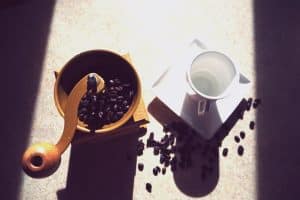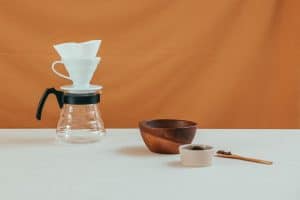The art of making pour-over coffee petered out with the introduction of the French press. That is until the third wave of coffee hit.
With coffee lovers ditching their drip coffee machines in favor of higher-quality coffee brewing methods, the pour-over is back and better than ever!
Pour-over offers better flavor than automatic drip. Not to mention, the brewing process is very straightforward. So if you have the right equipment and access to hot water — you’re good to go.
Want to get in on the pour-over craze?
Our step-by-step guide will show you exactly how to use a pour-over coffee maker. In the guide below, you’ll find everything from the coffee to water ratio to popular pour-over brands to grinding your beans.
How to Grind Your Beans for Pour-Over Coffee

For best results, buy freshly-roasted whole bean coffee and grind it yourself at home right before brewing.
You’ll want a medium-fine grind size. If you were going to use a Turkish coffee maker, you’d need finely ground beans.
Don’t own a coffee grinder yet?
We definitely recommend picking one up! When it comes to coffee grinders, ones with ceramic burrs are preferable over blade grinders. You’ll also find a burr grinder delivers a more consistent grind in less time.
You can get away with a hand burr grinder if you only plan to make one cup of coffee at a time. But for several cups, an electric grinder is worth the higher price tag.
Check out the Baratza Encore. Baristas love it for their home coffee set-ups. Or the Cuisinart DBM-8 if you’re on a budget!
We recently brewed and reviewed some killer coffee beans for pour-over! Read it here: Red Rooster Coffee Review: Old Crow Cuppa Joe.
Finding the Right Coffee-to-Water Ratio
This will take some playing around to find your particular preference. A good starting coffee-to-water ratio is 16:1*. Try 15 grams of water to one-part coffee if you like stronger coffee.
For example, you’d use 22 grams of coffee for 350 grams of water.
Consider buying a digital scale for a more accurate weigh-out of your coffee grounds.
Another coffee gadget we recommend for perfect pour-over is an electric kettle with a gooseneck spout. An electric kettle dials in your hot water temperature, while a gooseneck kettle provides you control over your water flow rate.
*This ratio is best if using single-origins. However, for blends, you may find you need more grams of coffee to achieve your perfect cup.
Step-By-Step Guide for Making Perfect Pour-Over Coffee
This brew guide will assume you use a standard dripper like the Kalita Wave or Hario V60.
Let’s brew coffee!
- Grind your beans until they’re the consistency of sea salt.
- Measure out your coffee grounds (we’re using 350 grams of water and 22 grams of coffee for ours!).
- Fill your kettle with enough water and bring it to a boil (or if using an electric, set it to 205 degrees Fahrenheit).
- While your water is heating, load your dripper with a paper filter.
- Optional: wet your filter.
- Add your coffee grounds to the filter and level them.
- Put your whole set-up on a digital scale and zero it out (skip this step if you don’t have a scale).
- If you didn’t use an electric kettle and your water came to a full boil, let it rest for 30 seconds before the next step.
- Starting at the edges and spiraling in, slowly pour water over the coffee grounds until they’re saturated (about 60 grams of water if you’re using a scale).
- Let the coffee “bloom” for about 30 seconds (you may wish to use a timer).
- For the second pour, start from the center of the grounds and spiral outward, then back in. Give the coffee at least 45 seconds before moving on to the next pour (if using a scale, aim to add 90 grams at this step, bringing your total weight up to 150 grams).
- Repeat step 11 with another 100 grams of water (~¼ cup of hot water for non-scale users). The best pour should take 15-20 seconds.
- Pour in the final 100 grams of water.
- Remove the dripper, compost your coffee grounds, and sip your fresh pour-over slowly — savoring its bouquet of flavors!
It sounds like a lot, but the total brew time is only around three minutes. After the first “bloom” pour, you could skip right to adding the remaining water. But coffee lovers will appreciate the zen experience of slowing down and adding those extra intentional pours.
(And the result will speak for itself!)
Craving a Latte?
While pour-over is far from espresso, it is delicious with a dash of milk or cream.
Or, you can make a latte-like beverage by brewing your pour-over twice as strong before adding hot or steamed milk.
How To Make Iced Coffee Using the Pour-Over Coffee Method
Some days call for an ice-cold coffee. While you can’t really use the pour-over method for cold brew, the good news is it makes excellent iced coffee — and it makes it fast!
The brewing directions are the same as making regular pour-over coffee*.
The differences are:
- You’ll first fill the glass you’re brewing into with ice (140 grams is good if you’re really into weighing things!). You may need to pop in another cube after brewing. You can even try adding a slice of orange if you’re feeling fancy, especially if you used a fruity light roast for your coffee grounds.
- You can also get away with slightly reducing the amount of coffee since you’re using less water, but we’d still suggest using around 20 grams.
It’s called flash chilling and is much tastier than the old method of waiting for brewed coffee to cool — no flavor loss!
*Because of the room the ice takes up in the glass, you will use less water when brewing. AKA: skip step 13 from the instructions above and pour a little less on step 12.
The pour-over method may not work for cold brew. But you can master the secrets to making nitro cold brew at home!
Top Pour-Over Coffee Maker Brands

Let’s talk coffee brewers.
Hario V60 Coffee Dripper
This classic ceramic dripper has a minimalist look that offers maximum coffee flavor. Handmade in Japan, you can get this dripper in two different sizes and colors.
Key Features
- Single large hole for pour control
- Spiral design
- Heat-retaining ceramic
- Budget-friendly
The cone shape plus spiral ridges help you layer the coffee bed during brewing. This makes it easier to saturate coffee grounds and leads to better extraction. Besides using great beans, good coffee is all about nailing extraction times — life’s too short to drink bitter coffee!
The larger size holds 300 milliliters at a time and costs under $25 on Amazon. But, of course, you’ll also want to order a pack of paper filters like these.
Kalita Wave 185 Drippers
The Kalita Wave pour-over drippers come in three different materials: stainless steel, ceramic, and glass. We’ll focus on the stainless steel one here.
Key Features
- Flat-bottom coffee bed
- 3-hole design
- Durable
- Dishwasher safe
Unlike the HarioV6, which has a single large hole for pour flow, the Kalita Wave has three. The stainless steel option is more durable and easier to clean, but perhaps not as elegant-looking.
It’s a bit pricier than the V60, with the large size going for just over $40 on Amazon. You’ll also need to buy the correct paper filters for it (they aren’t included).
Melitta Porcelain Pour-Over Cone
The Melitta dripper looks as sweet as its name suggests. You can grab one in glossy white or black.
Key Features
- Full height ridges for optimal extraction
- Easy to use (beginner-friendly)
- Comes with filters
- Viewing holes
The high-quality porcelain is even dishwasher safe (most likely top-rack only). What we love about the Melitta is that it has two viewing windows so you can watch your brew and prevent overflowing accidents.
You’ll also appreciate its budget-friendly price tag of just over $25 on Amazon. Yes, that’s a few bucks more than the V60 However, it includes a starter pack of paper filters!
Chemex 3-Cup Glass Pour-Over Coffee Maker
We can’t talk filter coffee and neglect to mention the Chemex!
You’ve likely spied one for sale at your local coffee shop. The carafe’s unique hourglass design is nothing short of eye-catching.
Key Features
- Will not absorb odors or chemical residues
- Polished wood collar w/ leather tie for gripping
- Aesthetic
- Brews multiple cups
Made of high-quality Borosilicate glass, it’s dishwasher safe, and you can even store coffee in the fridge (covered) in your Chemex.
To brew Chemex, use a medium-coarse grind size instead of medium-fine. You’ll also need the right coffee filters and learn how to fold them. They should come with instructions, but just in case, you can find some here.
You can brew up to three 5-ounce cups of pour-over at a time with a Chemex. Bring one home now for under $45 on Amazon.
Automatic Pour-Over Coffee Makers
We’re not even kidding; they exist!
If you want the flavor of pour-over with a less hands-on experience, check these out. These machines handle the water temperature and extraction times for you. But, unsurprisingly, they will set you back more than a manual set-up.
Plus, it solves that potential only-one-cup-of-coffee-at-a-time issue. Very important for households with multiple coffee lovers.
Related: We compared the Moka Pot vs. French Press.
Best Coffee Beans for Pour-Over

Since the appeal of the pour-over method lies largely in the coffee flavor experience, it pays to choose high-quality beans.
Light Roasts
Light roast coffee beans are roasted only to the first crack. As a result, they retain more of their origin flavors by pulling them out of the roaster before they heat further. That’s where you get those coveted floral and fruity notes.
With its even extraction time, the pour-over method really lets those light roast tasting notes sing. But you can use a medium roast for pour-over if that’s more your speed.
Dark roasts aren’t the norm for pour-over. However, if you want to go that route, we recommend dialing back your water temperature a tad.
Single-Origins
When sourcing beans, you may encounter the term “single-origin.” That means the coffee beans are from a single geographical region or even a single producer or crop.
It may surprise you (or may not) that a lot of coffees are actually blends of beans from different farms.
The beauty of single-origin, besides traceability, is those origin flavors we mentioned when talking about light roasts. Each growing region infuses natural, unique tasting notes into its coffee crops.
In our humble (if caffeinated) opinion, the higher price tag of a bag of single-origin beans is totally worth it for delicious coffee.
Need help choosing the right light roast beans for the perfect cup of pour-over? Learn more about the best light roast coffees on the market.
Conclusion
Once you get the hang of the pour-over coffee method, we doubt you’ll be turning to your old drip coffee maker much anymore (unless you’re entertaining a crowd!).
For entertaining one or two friends, though, why not show off your sweet home barista skills?
Now you can make great coffee at home, hot or iced, instead of braving those coffee shop lines.
Enjoy connecting with your coffee through this new brewing ritual. We find it to be a very zen experience.


![Batch Brewing Great Coffee [Full Breakdown]](https://caffeinecraze.com/wp-content/uploads/2023/02/unnamed-10.jpg)

